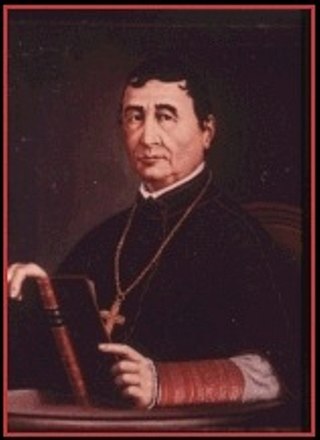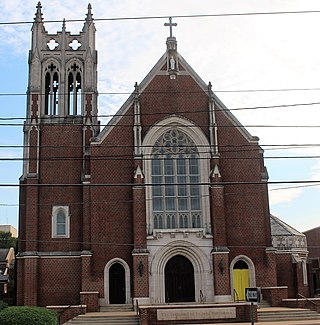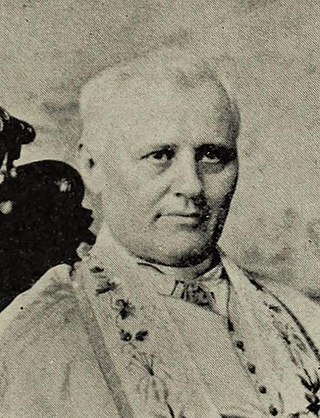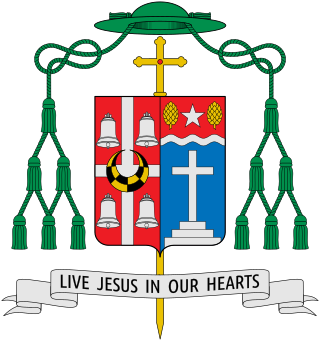
The Diocese of Natchitoches (Latin : Dioecesis Natchitochensis) was a Latin Church residential episcopal see of the Catholic Church from 1853 to 1910 and is now a titular see.

The Diocese of Natchitoches (Latin : Dioecesis Natchitochensis) was a Latin Church residential episcopal see of the Catholic Church from 1853 to 1910 and is now a titular see.
Originally, the bishopric of Natchitoches was the Catholic Diocese for the central portions of Louisiana —all the northern part of Louisiana above 31° N. lat., with an area of 22,212 square miles—when it was established on July 29, 1853. [1] The diocese was headquartered in Natchitoches, Louisiana. The see city was later relocated to Alexandria, Louisiana and the diocese was renamed the Diocese of Alexandria. Since that time the Diocese of Natchitoches has been maintained as a titular see.
Antonio Margil was the first priest to minister within the territory now forming the diocese. From the Ays Indians, west of the Sabine river, Father Margil heard of the Adayes Indians, and in March, 1717, he located them near Spanish Lake, in what became Sabine Parish, Louisiana, founded the mission of San Miguel de Linares and built there probably the first church in Louisiana, for according to the historian Martin, when Pere Charlevoix reached New Orleans in 1721, he found there "about 100 cabins, two or three dwelling houses and a miserable storehouse which had been at first occupied as a chapel, a shed being now used for that purpose". Leaving Father Gusman in charge, Father Margil journeyed on foot to Natchitoches to minister to the French Catholics there, and then went back to Texas.
In 1718, during the brief war with Spain, Blondel, the French Commandant at Natchitoches, invaded the Adayes mission, plundered it and carried away the church vestments. Father Margil heard of it, and in 1721 came back, hunted up the Adayes who had taken refuge in the forests for fear of the French, rebuilt their church, which he dedicated to Our Lady of the Pillar, the patroness of the expedition. For many years afterward the Adayes mission was attended from San Antonio by the Franciscans, who attended also the missions of Nacogdoches and St. Augustin, Texas. In 1725 there were 50 Catholic families at Natchitoches. In 1728 Father Maximin, a Capuchin, was in charge.
There is no record to show how the eastern portion of the diocese was evangelized; but the Catholic names given to villages and lakes contiguous to the Mississippi, show that priests must have visited that country, probably the Jesuits, who in the 18th century had charge of the Indians along the Mississippi under the Bishop of Quebec. The records show that in 1829 Father Martin of Avoyelles attended the Catholics on the Red, Black and Ouachita rivers; that, in 1840 and after, Father J. Timon, afterwards Bishop of Buffalo, made regular trips from Texas to attend the north Louisiana missions, and that Father O'Brien, a Dominican from Louisville, attended yearly the Catholics along the Mississippi. The Catholics located on the rivers of the state often drifted to New Orleans on barges to have their marriages blessed and their children baptized, and come back cordelling their boats.
In 1852 the Fathers of the First Council of Baltimore recommended to the Holy See the division of the Archdiocese of New Orleans, the formation of the Diocese of Natchitoches and the appointment of Father Martin, parish priest at Natchitoches, as its first bishop. Consecrated in 1853, he had four priests in the new diocese, three of whom returned to New Orleans, to which diocese they belonged, and one remained.
Bishop Augustus Marie Martin (1802–1875), born in Brittany, inherited the deep faith of the Bretons. A protégé of Abbe Jean-Marie de Lamennais, as a seminarian, he was employed at the great Almonry of France in Paris under Cardinal Prince de Troy and Vicar-General J.-M. de Lamennais. There he came in contact with Montalembert and other disciples of Felicite Lamennais and acquired the polished manners that never left him. In 1839, while chaplain of the royal college in Rennes, he met Bishop Célestine Guynemer de la Hailandière of Vincennes, came to Indiana with him, and for six years was his vicar-general. His health failing, he came to Louisiana, and in 1852 was vicar-general of Mgr. Blanc of New Orleans. Bishop Martin left a collection of unpublished letters that tell the history of his diocese, his struggles with poverty, his many trips to France to recruit his clergy. A fluent writer, his letters to the Propagation of the Faith were inserted in the "Annals"; the bishops of the Second Council of Baltimore and those of the provincial Council of New Orleans delegated him to write letters of thanks to the directors of the Propagation of the Faith for their generous contributions. Both letters were reproduced in "Les Missions Catholiques". Bishop Martin left an organized diocese with 20 priests, the Sisters of the Sacred Heart with one convent at Natchitoches, and the Daughters of the Cross with their mother-house and several convents in the diocese.
He was succeeded by Bishop F. X. Leray, also a Breton, the hero of several yellow fever epidemics, and the founder of the Sisters of Mercy in the Diocese of Natchez. He remained in Natchitoches only two years, being selected as coadjutor to the Archbishop of New Orleans. He died in 1887.
Bishop Anthony Durier succeeded him. Born near Lyon in southern France, he came to this country in 1855, was pastor in New Orleans for 26 years and one of the theologians of the Second Council of Baltimore. Consecrated in 1885, he died in 1904, having finished the cathedral and built an episcopal residence at Natchitoches.
Right Rev. Cornelius Van De Ven, born at Oirschot, Holland, 16 June 1865, who studied in the diocesan seminary of Den Bosch, was ordained 31 May 1890, and came to America the same year. After filling important posts in the Archdiocese of New Orleans, he was consecrated Bishop of Natchitoches 30 November 1904. The most important act of his administration has been the transferring of the see from the inaccessible town of Natchitoches to the progressive city of Alexandria, a railroad centre with a large Catholic population. He went to Rome in 1910 and requested Pius X for the removal of the see. In August 1910, he received from the Consistorial Congregation the decree suppressing the See of Natchitoches and creating the See of Alexandria.
On 6 August 1910, Pope Pius X transferred the see and changed the title of the diocese to Diocese of Alexandria . At that time, a total of 26 diocesan priests, 10 regulars (Jesuits and Marists), the Brothers of the Sacred Heart, the Daughters of the Cross with mother-house at Shreveport, the Sisters of Divine Providence and the Sisters of the Incarnate Word served about 23,341 parishioners.

Robeline is a village in western Natchitoches Parish, Louisiana, United States. The population was 183 at the 2000 census. It is part of the Natchitoches Micropolitan Statistical Area.

The Diocese of Alexandria in Louisiana is a Latin Church ecclesiastical territory, or diocese, of the Catholic Church in central Louisiana in the United States. It is a suffragan diocese in the ecclesiastical province of the metropolitan Archdiocese of New Orleans.

Antoine Blanc was the fifth Bishop and first Archbishop of the Roman Catholic Archdiocese of New Orleans. His tenure, during which the diocese was elevated to an archdiocese, was at a time of growth in the city, which he matched with the most rapid church expansion in the history of New Orleans. More new parishes were established in New Orleans under his episcopacy than at any other time.

Michael Portier was an American Catholic bishop who served as the first Bishop of Mobile from 1829 until his death in 1859.

The Diocese of Shreveport is a Latin Church ecclesiastical territory, or diocese, of the Catholic Church covering the parishes of northern Louisiana in the United States.

Jean-Marie Robert de La Mennais, FICP was a Breton Catholic priest and brother of the philosopher Felicité Robert de Lamennais, whom he influenced in their youth. He was a leading figure in the revival of the Catholic Church in France after the French Revolution, involved in founding three religious institutes as part of this effort.

St. Augustine Catholic Church and Cemetery, or the Isle Brevelle Church, is a historic Catholic parish property founded in 1829 near Melrose, Natchitoches Parish, Louisiana. It is the cultural center of the Cane River area's historic French, Spanish, Native American and Black Creole community. It is also the oldest surviving Black Catholic church in the United States.

Augustus Marie Martin was a French-born prelate of the Roman Catholic Church. He served as the first bishop of the Diocese of Natchitoches in Louisiana from 1853 until 1875.

Francis Xavier Leray was a French-born prelate of the Roman Catholic Church who served as bishop of the Diocese of Natchitoches in Louisiana (1877–1879) and as archbishop of the Archdiocese of New Orleans (1883–1887).

Anthony Durier was a French-born American prelate of the Catholic Church. He served as the third bishop of the Diocese of Natchitoches in Louisianan from 1885 until his death in 1904.

Cornelius Van de Ven was a Dutch-born American prelate of the Catholic Church. He served as the fourth Bishop of Alexandria in Louisiana from 1910 until his death in 1932. He previously served as bishop of the Diocese of Natchitoches in Louisiana from 1904 until its dissolution in 1910.

The St. Anne Church in the vicinity of Robeline, Louisiana is a historic church founded in the 1800s as a mission from the St. Augustine Parish Church of Isle Brevelle. The current building was built in 1916. It is located at the southwest corner of the intersection of LA 485 and Blosmoore Road. It was added to the National Register in 1994.

Robert William Marshall, Jr. is an American prelate of the Catholic Church who has been serving as Bishop of Alexandria in Louisiana since 2020.

Isle Brevelle is an ethnically and culturally diverse community, which began as a Native American and Louisiana Creole settlement and is located in Natchitoches Parish, Louisiana. For many years this area was known as Côte Joyeuse. It is considered the birthplace of Creole culture and remains the epicenter of Creole art and literature blending European, African, and Native American cultures. It is home to the Cane River Creole National Historical Park and part of the Louisiana African American Heritage Trail.
Bayou Brevelle is a series of interconnected, natural waterways totaling over 18 miles in length in Natchitoches Parish, Louisiana. Its main channel is at Old River and Kisatchie Bayou at Montrose to Natchez near the Cane River. During heavy rains or floods, Bayou Brevelle joins the Cane River. The bayou is flanked by Interstate 49 on the west and the Cane River on the east, and is one of the many waterways on Isle Brevelle.
The Adai Caddo Indians of Louisiana is a state-recognized tribe in Louisiana and 501(c)(3) organization in Robeline, Louisiana. Its members identify as descendants of the Adai people. The chief is John Mark Davis, as of 2023.
St. Anne Chapel at Old River is a historic Catholic chapel founded in the 1800s along the banks of Old River near Cypress and Isle Brevelle in Natchitoches Parish, Louisiana, serving the Old River community. It is the cultural and religious center of the area's Louisiana Creole people, predominantly of French descent.
St. Charles Chapel at Bermuda is a historic Catholic chapel founded in the early 1900s along the banks of the Cane River on Isle Brevelle in Natchitoches Parish serving the unincorporated community of Bermuda, Louisiana. It is the cultural and religious center of the area's Louisiana Creole people, predominantly of French descent.
St. Joseph's Catholic Mission at Bayou Derbonne is a historic Catholic mission founded in the 1800s along the banks of Bayou Derbonne near Montrose and Isle Brevelle in Natchitoches Parish, Louisiana, serving the Montrose and Cloutierville Creole community. It was the cultural and religious center of the area's Louisiana Creole people, predominantly of French descent.
Jean Baptiste Brevelle II was a French and Native American explorer, translator and soldier of the militia at Fort St. Jean Baptiste des Natchitoches in present-day Natchitoches, Louisiana and Le Poste des Cadodaquious in Texas.